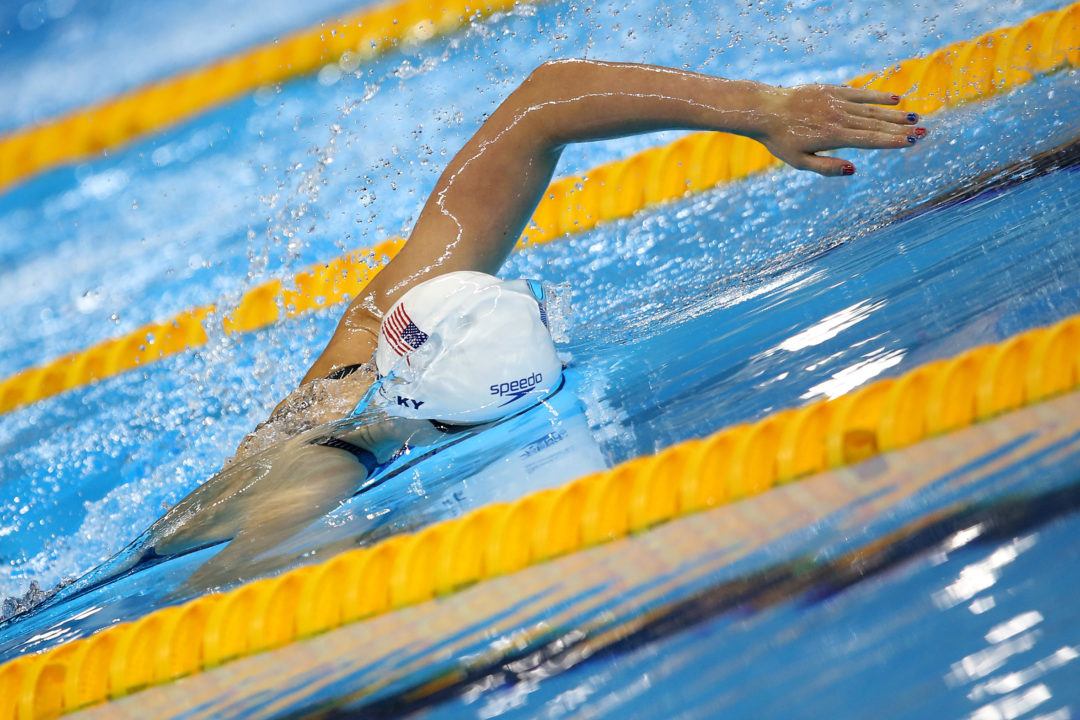Courtesy of Gary Hall Sr., 10-time World Record Holder, 3-time Olympian, 1976 Olympic Games US Flagbearer and The Race Club co-founder.
Somewhere along the line of learning freestyle and backstroke technique, many swimmers have been told to enter their hands delicately in the water. As the arm recovers over the top of the water, just before entering the water, the swimmer will slow the velocity of the hand and arm down to avoid crashing them into the water. I call this the ‘modern toilet seat’ syndrome, because in swimming freestyle and backstroke, the hand slows down just like a modern toilet seat with a spring on it to keep it from falling down hard. The rationale of this technique is to avoid getting air bubbles surrounding the hand during the underwater pull, which results in a loss of propulsion.
While it is true that reducing the number of bubbles on the hand will increase propulsion, laying the hand down softly in the water or sliding the hand forward in the water in front of the head are bad ideas. First, I am not convinced that either of these techniques will reduce the number of air bubbles around the hand. It seems that has more to do with a swimmer’s proprioceptive feel for the water than the speed of the hand at entry. I have watched countless elite swimmers aggressively throw their hands into the water with tremendous speed and force, yet somehow they manage to avoid getting a lot of air trapped behind their hands. I have also seen many poor swimmers enter their hands delicately in the water and create a virtual stream of air bubbles following their hand on the pulling motion. Second, slowing the hand at entry will slow the stroke rate, a key component to fast swimming freestyle and backstroke.
Third, and what is most important, is that by slowing the hand at entry, swimmers are losing out on a great opportunity to increase their speed. In freestyle and backstroke, there are two important coupling motions that augment the propulsive forces from our hands and feet (pull and kick); the arm recovery and the body rotation. Of the two, because the mass of the body is significantly greater than the arm, the body rotation is more important, but the two motions are linked to one another. Arm recovery couples with the underwater pull only when using shoulder-driven or hybrid freestyle. Coupling motions only work when acting during the propulsion or while the propulsion is still in effect (shortly after the propulsion takes place). The degree to which the coupling motions work depends on their kinetic energy; the speed of the body rotation (angular velocity) and the speed and length of the recovering arm (angular velocity and radius). In other words, the faster the body rotates and the faster and longer the arm recovers, the more powerful the underwater pull becomes.
As with so many things in life, the same holds true for coupling motions. Timing is everything. To maximize the coupling effect, one needs to see the greatest kinetic energy occur in the coupling motion precisely during the strongest force in the propulsion. For backstroke and shoulder driven freestyle, that occurs in the last 25% of the arm recovery, or in other words, right before the hand enters the water. To achieve that, a swimmer should accelerate the hand and arm as they approach the water, not slow them down.
Further, the speed of the hand at entry is also linked to the body rotation speed during this critical time. If one slows the hand down at entry, then the body rotation also slows. If one accelerates the hand at entry, the body snaps quickly to the other side. The speed of the recovering arm during that final 25% of the recovering motion therefore controls two key components to gaining speed, arm recovery and body rotation.
I was struck at the Olympic Trials watching Ryan Murphy and Jacob Pebley throw their hands backward with great force during the last quarter of the recovery in their 1-2 finish in the 200 backstroke. Kudos to Dave Durden for teaching them that great technique….or to each of them for figuring it out. Either way, it worked out well for them.
One of my favorite drills we teach at The Race Club using this aggressive hand entry/body rotation technique is the six-kick, one-stroke drill with fins on. Regardless of whether one uses a low octane or high octane recovery (bent or straight arm), one can feel the increase in power that is generated by the fast final entry of the hand and arm, creating a quick rotation of the body.
Watch Swimisode: Freestyle Swim Drills: 6 Kicks 1 Stroke
Watch Swimisode: Fast Backstroke Swim Technique
My advice is to forget about the air bubbles. Avoid the ‘modern toilet seat’ syndrome. Focus on coupling with your arm, hand and body by accelerating the recovering hand to entry and see what happens.
Yours in swimming,
Gary Sr.
Like The Race Club on Facebook
Follow The Race Club on Instagram

Gary Hall, Sr., Technical Director and Head Coach of The Race Club (courtesy of TRC)
Follow The Race Club on Twitter
Connect to The Race Club / Gary Hall Sr. on Linkedin
THE RACE CLUB
Because Life is Worth Swimming, our mission is to promote swimming through sport, lifelong enjoyment, and good health benefits. Our objective is for each member of and each participant in The Race Club to improve his or her swimming performances, health, and self-esteem through our educational programs, services and creativity. We strive to help each member of The Race Club overcome challenges and reach his or her individual life goals.
 The Race Club provides facilities, coaching, training, technical instruction, video, fitness and health programs for swimmers of all ages and abilities. Race Club swim camps are designed and tailored to satisfy each swimmer’s needs, whether one is trying to reach the Olympic Games or simply improve one’s fitness. Our programs are suitable for beginner swimmers, pleasure swimmers, fitness swimmers, USA swimming or YMCA swimmers, or triathletes; anyone who wants to improve swimming skills. All of our Race Club members share an enjoyment of being in the water and use swimming to stimulate a more active mind and body.
The Race Club provides facilities, coaching, training, technical instruction, video, fitness and health programs for swimmers of all ages and abilities. Race Club swim camps are designed and tailored to satisfy each swimmer’s needs, whether one is trying to reach the Olympic Games or simply improve one’s fitness. Our programs are suitable for beginner swimmers, pleasure swimmers, fitness swimmers, USA swimming or YMCA swimmers, or triathletes; anyone who wants to improve swimming skills. All of our Race Club members share an enjoyment of being in the water and use swimming to stimulate a more active mind and body.
AB
